This post was originally published on this site
MADRID — High above the streets of central Madrid, where Calle de Sevilla and Calle de Alcalá meet, stands a landmark 100-year old rotunda and bell tower, flanked by two golden statues: Life, holding an hourglass, and Death, clutching a wheel of fortune.
It’s the crowning architectural flourish of the luxury Four Seasons Hotel Madrid, which opened last September on the site of the former Banesto bank headquarters. That ribbon cutting coincided with the second wave in Spain of a pandemic that has now left 80,911 people dead, and a tourism industry battling to survive.
The 200-room hotel near the central Puerta del Sol, one of the busiest plazas in this capital city, is housed in seven restored and repurposed historical structures. Behind its largely intact 19th-century façades, the hotel inherited marble fittings, doorknobs and mirrors that are now intermixed with modern décor. For the first time in its history, bell-tower closeups are open to the public, who can dine or enjoy a €7 ($8.31) coffee at the rooftop restaurant.
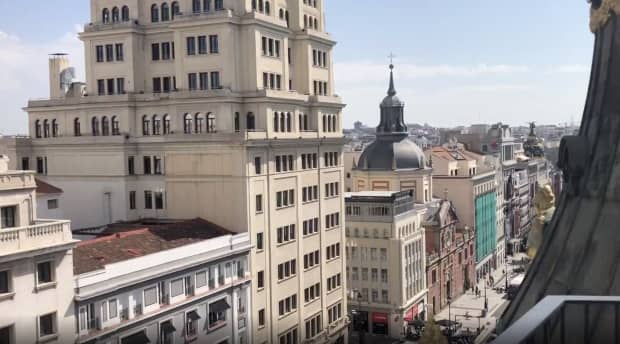
Rooftop views from the Four Seasons.
MarketWatch/Barbara Kollmeyer
The goal at the time of the hotel’s opening was simple: Bring cheer and distraction to an isolated and COVID-19–weary public, Marta Centeno Sampere, the hotel’s director of public relations and communications, told MarketWatch in mid-June.
“It was a time where it seemed right to open; it was a positive message for the city of Madrid,” said Centeno Sampere. The hotel had yet to welcome a single U.S. guest at the time of the interview but recently reported a pickup in demand.
Spain’s tourism minister, Reyes Morato, is hoping to see 45 million visitors this year, barely more than half of 2019’s record-breaking 83.7 million. The country was the world’s second most popular destination next to France in 2019, with the tourism industry accounting for 13.9% of all Spanish jobs. While activity has been picking up, the Bank of Spain still projects a jobless rate of 15% this year, the second highest in Europe.
The government has been racing to stay ahead of the already present and highly contagious delta variant sweeping across neighboring Portugal and the U.K. Rising infections among the younger, unvaccinated crowd have driven the 14-day infection rate in Spain to 152 per 100,000, a level not seen since March. Using 24-hour vaccination sites in some spots, 38.9% of the public has now been fully vaccinated.
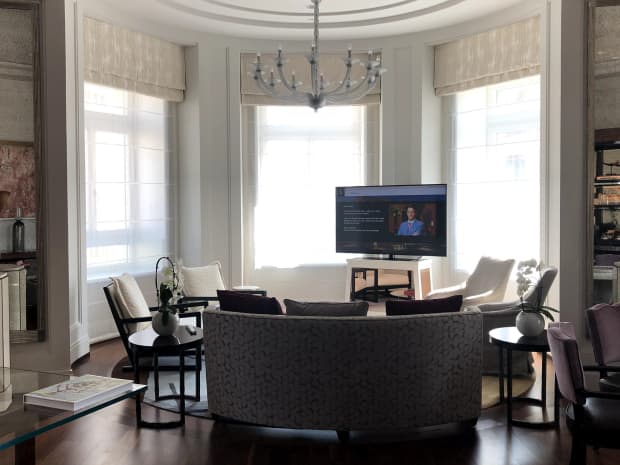
Inside a two-bedroom suite at the Four Seasons Hotel Madrid whose nightly rate is roughly €8,000.
MarketWatch/Barbara Kollmeyer
For now, the country is open to vaccinated travelers and those who can provide a negative COVID-19 test. After more than a year and one of the world’s strictest lockdowns, Spain last month eased outdoor mask rules, provided 1.5 meters of social distance can be observed. Many here still wear masks. Indoor mask use is strictly enforced.
A desperate wait
The tourists cannot come fast enough for 41-year-old Madrid-based flamenco dancer Vanesa Coloma Suárez and her partner, Alfonso Losa, whose livelihood — like that of many — depends on the fiery, centuries-old dance that was declared a World Heritage Treasure by Unesco in 2011.
“It’s clear that people have the desire to go to the theater, but desire is one thing, and ability is another, so far things are very slow and [that is] affecting the tablaos,” Suárez said in May, referring to venues for flamenco shows. Some tablaos have been shuttered for good, including Villa Rosa, which opened in 1911, and Casa Patas, with more than 30 years of history, both in Madrid.
According to an April report by RTVE Televisión, more than 700,000 families in Spain depend on the country’s arts sector, which lost 36% of its income in 2020.
Complications for flamenco’s local survival are the facts that the venues weren’t open daily, audiences were much smaller, and food couldn’t be served at many tablaos, causing related job losses, Suárez said. And even pre-pandemic, there seemed to be a shortage of places to perform. She said the pair had had to get creative.
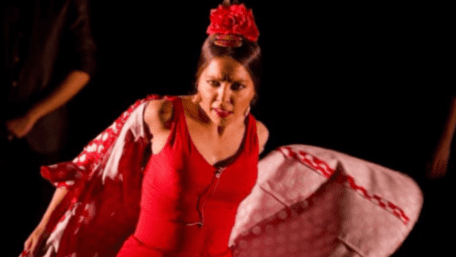
Flamenco dancer Vanesa Coloma Suárez performs in 2012.
Courtesy of Vanesa Coloma Suárez
“As my partner had an online website from seven years ago, we decided, as we were without work, to make a new platform and give classes online. It was a way of trying to survive all these months of the pandemic, giving classes online to the whole world,” said Suárez, whose government unemployment assistance has run out.
According to Suárez, 90% of those who visit tablaos are tourists. “What happens when there are no tourists [is that] there are no tablaos, and, when there are no tablaos, artists aren’t working.”
The tourists must come back and fill the seats, but, equally, health concerns must be vanquished, Suárez said. Until then, recovery will be slow for her business. And it’s not alone.
They will come, and they must
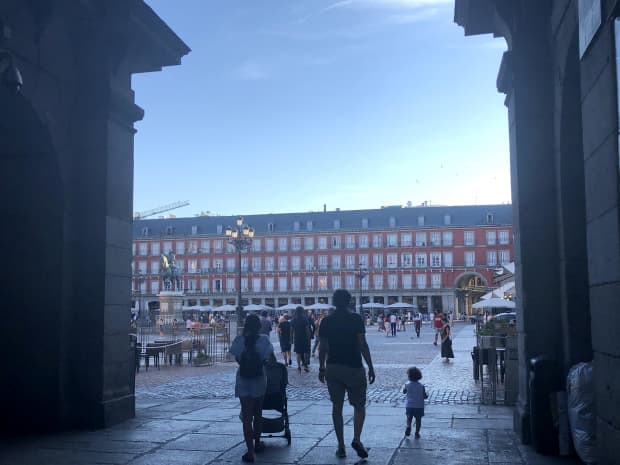
An archway leading to Madrid’s Plaza Mayor.
MarketWatch/Barbara Kollmeyer
It would be hard for any returning tourist not to notice differences in Madrid. A stroll around the majestic Plaza Mayor suggests several business there may not return. Nearby is one that has — Mercado de San Miguel — a gastronomic market in its original 105-year-old structure that reopened after nine months of closure. Pre-pandemic, the market claims to have welcomed 10 million visitors a year.
Beaches and food are among Spain’s biggest draws, along with almost year-round outdoor cafés that have helped locals cope and beckoned foreigners, especially with Madrid’s at times less restrictive public health rules.
“We have had, and there were a lot of political critics, thousands of friends coming all the weekends to enjoy Madrid rather than Paris,” said José Luis Zoreda, vice president of tourism lobby group Exceltur, in June.
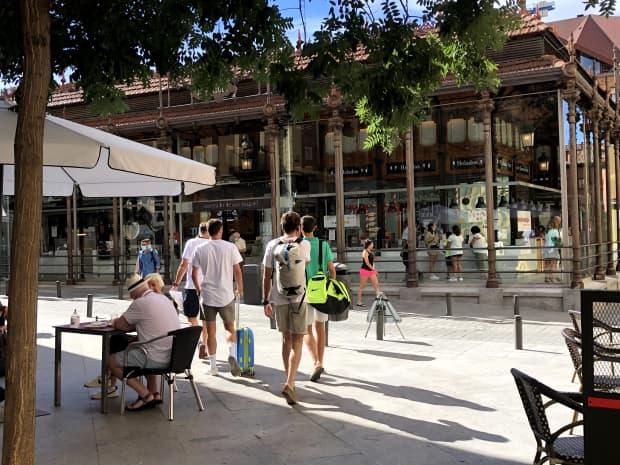
Visitors walking toward Mercado de San Miguel on July 2.
MarketWatch/Barbara Kollmeyer
Zoreda said he was optimistic Spain could get back 55% to 60% of its 2019 visitor total this year — though U.K. tourists would be relied upon to play a role in that achievement, and the Spanish government recently tightened up entry rules due to that country’s delta-variant spread.
Not far from Mercado de San Miguel is Tablao Las Carboneras, where manager Quique Enrique was encountered preparing for a weekend of flamenco shows. He said that, starting this month, the venue will be open six days weekly, even if he can’t be sure of full houses.
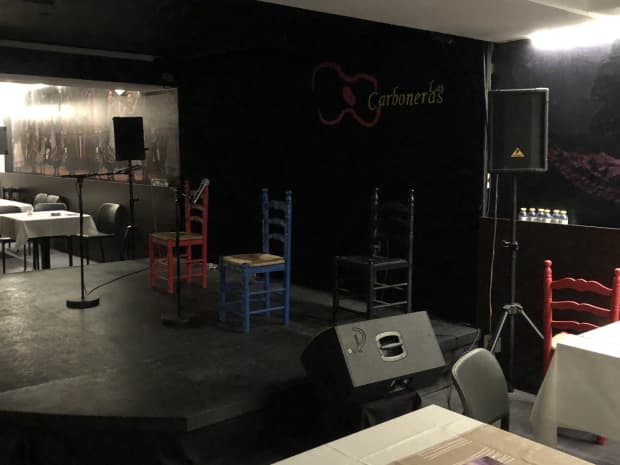
Madrid’s Tablao Las Carboneras, as seen on June 30.
MarketWatch/Barbara Kollmeyer
“A fruit vendor cannot sell if he doesn’t show his fruit,” said the 47-year-old Enrique. “You can’t say, well a lot has happened, and now we will return to [the way] we were before. No one can guarantee anyone anything … but if you don’t risk, you don’t gain.”
Stationed in his empty tablao, Enrique smiled broadly and insisted that Americans and other foreigners are coming back, and that he has all the hope in the world right now: “As long as we are alive, we are hopeful.”

